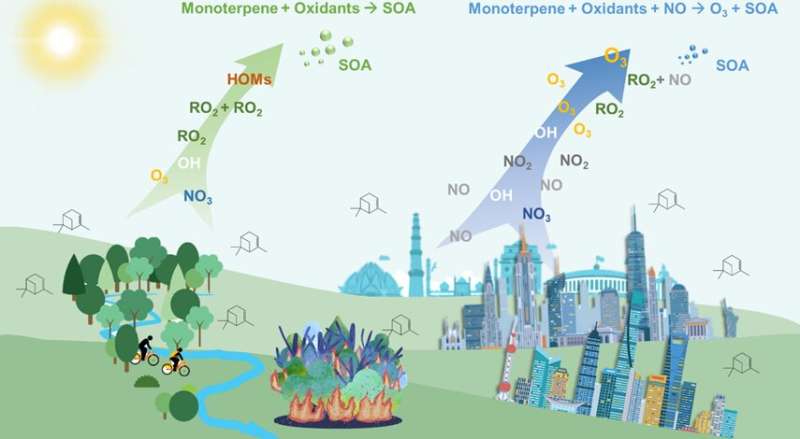In urban regions, high monoterpenes emissions are accompanied by high NOx emissions. With the interactions of NOx, the monoterpene derived RO2 (an intermediate of monoterpene oxidation) can produce large amounts of O3 as well as secondary organic aerosols (SOA). While in forest regions, although monoterpene emissions are large, with fewer NOx interactions, the O3 production is limited and thus only produce SOA. Credit: Science China Press
This study was led by Prof. Keding Lu and Prof. Yuanhang Zhang from Peking University. They conducted a field campaign in Taizhou, Eastern China from May to June in 2018. They observed elevated levels of monoterpene, a formerly considered biogenic emitted Volatile Organic Compounds (VOCs), and determined a rapid oxidation rate by OH radical, O3 and NO3 radical observed with in-situ state-of-art instrumentations. Such fast oxidation rate of monoterpene even exceeded that of isoprene, which was thought to be the dominant biogenic emitted VOCs.
"In the beginning, we were very confused because the biogenic emission of monoterpene was not able to sustain the observed concentrations with such high level of oxidants. We carefully checked our data to ensure no mistakes. Several modeling researchers also helped us to reproduce this cause but all failed," Keding says.
Since the biogenic emissions in eastern China could not explain the observation, they wondered if there was another monoterpene source. Finally, a kind of unrecognized source of monoterpenes was uncovered. They noticed that strong biomass burning events happened in this region and these activities were also captured by detecting the gas tracers. Based on the correlation analysis of nocturnal monoterpenes and CO (a tracer of biomass burning), they revealed that monoterpenes were likely emitted from biomass burning. The deduced that monoterpene emission ratio to CO is also consistent with the reported values from laboratory studies.
After revealing the potential source of monoterpenes, the researchers used an observation-based box model to quantify the contribution of monoterpene oxidation to local ozone production. It was found that the oxidation of monoterpenes during daytime can provide an additional ozone by about 4 ppb, accounting for about 6% of the total ozone production during the daytime. Among them, anthropogenic monoterpenes absolutely dominated the contribution. For a 4-day biomass burning active episode, the increase further went up to 9 ppb (13%). "This is a very large source of ozone but not yet recognized. It should be attention-getting for policy makers," Keding says.
Although monoterpenes are also emitted in forest regions intensively, people don't worry about their contribution to ozone production, because nitrogen oxides, another precursor for ozone production, is very much limited in such environments. However, in urban regions with high NOx emission, the role of anthropogenic monoterpenes on ozone production can be sharply enhanced. They also showed that in other urban areas in developing countries, for example in Delhi, India, the contribution of strong monoterpenes emission (might also be caused by human activities) to ozone production can reach up to 10%. In addition, recent studies showed that large amounts of monoterpenes sourced from the volatile chemical products evaporation in cities like New York, and their environmental impacts deserve further attention.
The current anthropogenic VOC emission reduction strategies for ozone pollution control barely consider the anthropogenic monoterpene emissions. This study shows that the control of urban ozone pollution in China and other developing countries may be more challenging than expected if the effects of anthropogenic monoterpene emissions on ozone production are considered. Given that monoterpenes also contribute to the formation of atmospheric aerosols, controlling anthropogenic monoterpenes emissions will be a win-win solution to the joint control of ozone and fine particle pollutions.
The research was published in National Science Review.
More information: Haichao Wang et al, Anthropogenic monoterpenes aggravating ozone pollution, National Science Review (2022). DOI: 10.1093/nsr/nwac103
Provided by Science China Press
























